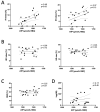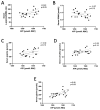Red Blood Cell Adenylate Energetics Is Related to Endothelial and Microvascular Function in Long COVID
- PMID: 38540167
- PMCID: PMC10968064
- DOI: 10.3390/biomedicines12030554
Red Blood Cell Adenylate Energetics Is Related to Endothelial and Microvascular Function in Long COVID
Abstract
Adenine nucleotides play a critical role in maintaining essential functions of red blood cells (RBCs), including energy metabolism, redox status, shape fluctuations and RBC-dependent endothelial and microvascular functions. Recently, it has been shown that infection with the severe acute respiratory syndrome coronavirus-2 (SARS-CoV-2) might lead to morphological and metabolic alterations in erythrocytes in both mild and severe cases of coronavirus disease (COVID-19). However, little is known about the effects of COVID-19 on the nucleotide energetics of RBCs nor about the potential contribution of nucleotide metabolism to the long COVID syndrome. This study aimed to analyze the levels of adenine nucleotides in RBCs isolated from patients 12 weeks after mild SARS-CoV-2 infection who suffered from long COVID symptoms and to relate them with the endothelial and microvascular function parameters as well as the rate of peripheral tissue oxygen supply. Although the absolute quantities of adenine nucleotides in RBCs were rather slightly changed in long COVID individuals, many parameters related to the endothelial and microcirculatory function showed significant correlations with RBC adenosine triphosphate (ATP) and total adenine nucleotide (TAN) concentration. A particularly strong relationship was observed between ATP in RBCs and the serum ratio of arginine to asymmetric dimethylarginine-an indicator of endothelial function. Consistently, a positive correlation was also observed between the ATP/ADP ratio and diminished reactive hyperemic response in long COVID patients, assessed by the flow-mediated skin fluorescence (FMSF) technique, which reflected decreased vascular nitric oxide bioavailability. In addition, we have shown that patients after COVID-19 have significantly impaired ischemic response parameters (IR max and IR index), examined by FMSF, which revealed diminished residual bioavailability of oxygen in epidermal keratinocytes after brachial artery occlusion. These ischemic response parameters revealed a strong positive correlation with the RBC ATP/ADP ratio, confirming a key role of RBC bioenergetics in peripheral tissue oxygen supply. Taken together, the outcomes of this study indicate that dysregulation of metabolic processes in erythrocytes with the co-occurring endothelial and microvascular dysfunction is associated with diminished intracellular oxygen delivery, which may partly explain long COVID-specific symptoms such as physical impairment and fatigue.
Keywords: endothelium; long COVID; microcirculation; nucleotides; red blood cells.
Conflict of interest statement
The authors declare no conflicts of interest.
Figures




Similar articles
-
Follow-up assessment of the microvascular function in patients with long COVID.Microvasc Res. 2025 Jan;157:104748. doi: 10.1016/j.mvr.2024.104748. Epub 2024 Sep 16. Microvasc Res. 2025. PMID: 39293561
-
A pilot study with flow mediated skin fluorescence: A novel device to assess microvascular endothelial function in coronary artery disease.Cardiol J. 2018;25(1):120-127. doi: 10.5603/CJ.a2017.0096. Epub 2017 Aug 25. Cardiol J. 2018. PMID: 28840593
-
Even patients with mild COVID-19 symptoms after SARS-CoV-2 infection show prolonged altered red blood cell morphology and rheological parameters.J Cell Mol Med. 2022 May;26(10):3022-3030. doi: 10.1111/jcmm.17320. Epub 2022 Apr 13. J Cell Mol Med. 2022. PMID: 35419946 Free PMC article.
-
Role of Nitric Oxide Carried by Hemoglobin in Cardiovascular Physiology: Developments on a Three-Gas Respiratory Cycle.Circ Res. 2020 Jan 3;126(1):129-158. doi: 10.1161/CIRCRESAHA.119.315626. Epub 2019 Oct 8. Circ Res. 2020. PMID: 31590598 Free PMC article. Review.
-
Adenosine 5'-Triphosphate Metabolism in Red Blood Cells as a Potential Biomarker for Post-Exercise Hypotension and a Drug Target for Cardiovascular Protection.Metabolites. 2018 May 2;8(2):30. doi: 10.3390/metabo8020030. Metabolites. 2018. PMID: 29724022 Free PMC article. Review.
Cited by
-
Long COVID Mechanisms, Microvascular Effects, and Evaluation Based on Incidence.Life (Basel). 2025 May 30;15(6):887. doi: 10.3390/life15060887. Life (Basel). 2025. PMID: 40566540 Free PMC article. Review.
-
Assessment of Microvascular Function Based on Flowmotion Monitored by the Flow-Mediated Skin Fluorescence Technique.Biosensors (Basel). 2024 Sep 25;14(10):459. doi: 10.3390/bios14100459. Biosensors (Basel). 2024. PMID: 39451673 Free PMC article. Review.
-
Special Issue "Latest Research in Post-COVID (Long COVID): Pathological and Treatment Studies of Sequelae and Complications".Biomedicines. 2024 May 27;12(6):1188. doi: 10.3390/biomedicines12061188. Biomedicines. 2024. PMID: 38927395 Free PMC article.
-
A New Approach to the Assessment of Erectile Dysfunction Based on Vasomotion Monitored by the Flow-Mediated Skin Fluorescence (FMSF) Technique-A Preliminary Study.J Clin Med. 2024 May 30;13(11):3210. doi: 10.3390/jcm13113210. J Clin Med. 2024. PMID: 38892921 Free PMC article.
References
Grants and funding
LinkOut - more resources
Full Text Sources
Miscellaneous

